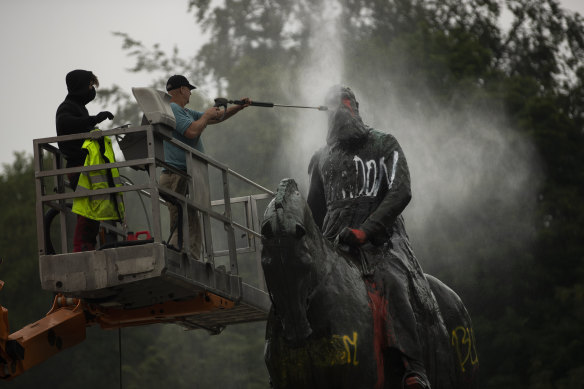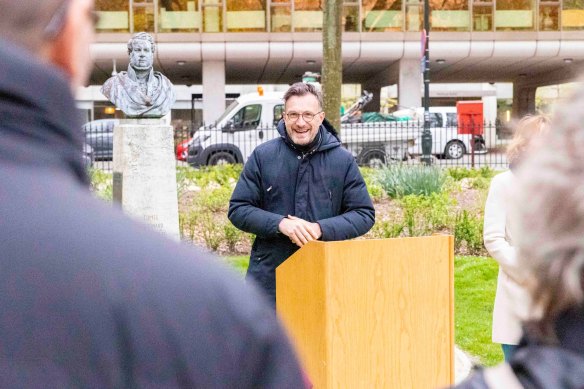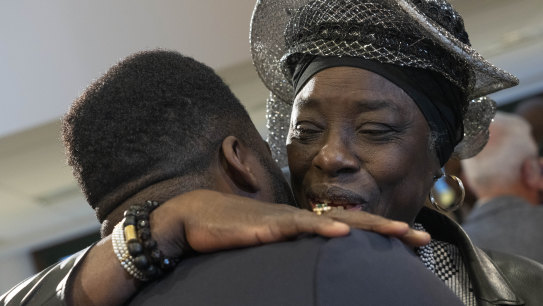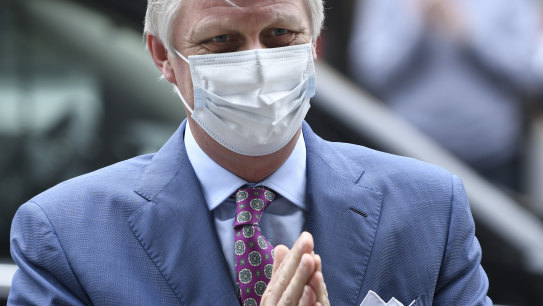‘Forgotten holocaust’: City confronts the ghost of its brutal Builder King

ByRob Harris
June 19, 2023 — 5.00am
Brussels: The ghost of Leopold II still looms large over the Belgian capital, a city that has long provided the political heartbeat of Europe.
In every corner of the place, the parks, avenues and buildings bear either Leopold’s name or honour the generals he sent to far off lands as part of his ambitious plans for his kingdom and its modest capital. He wanted to make Belgium a world power, and Brussels more beautiful than Paris.

Workers clean graffiti from a statue of Belgium’s King Leopold II in Brussels that was targeted by protesters during a Black Lives Matter demonstration in 2020. CREDIT:AP
Known as the Builder King, a man whose majestic statue on horseback still looms large outside the royal palace, Leopold II took control of the Congo during the 19th-century scramble for Africa. His ruthless and bloody plundering in the region has ever since left a stain on Belgium’s reputation.
Until a sharper focus over the past two decades, many Belgians had remained ignorant of their country’s harsh colonial rule over several African nations, including Rwanda and Burundi. Slave labour was used to harvest products including rubber. The proceeds laid the foundation for the modern-era prosperity of Belgium, a country of 11.5 million people and home to European Union institutions.
But now Brussels, having endured mass protests as part of the Black Lives Matter movement three years ago, is intent on correcting and contextualising its history as the government embarks on a world-first program to decolonise its public spaces.
“Most ordinary people just don’t know, or sometimes care, but it is part of our history and for Brussels, as a multicultural city, everybody has to recognise it,” says the city’s planning and heritage minister, Pascal Smet, who launched a 14-point plan this month to make the city more inclusive and aware of its past.

Pascal Smet, Brussels’ minister for planning and heritage, is addressing symbols in public spaces related to the colonial period.
“The whole idea of this is let’s recognise the past, let’s embrace it and don’t fall into the trap of individually blaming citizens. It’s a collective responsibility of the past. And so, we have collectively to recognise it as a society.”
Belgium only began to seriously confront Leopold’s regime after the publication in 1998 of Adam Hochschild’s King Leopold’s Ghost, which detailed the systematic cruelty of his rule. Hochschild shocked the world with the horrific figure of 10 million Congolese dead in a “forgotten holocaust” – a figure some historians continue to dispute.
Early reports of the horrors prompted the emergence in the 1900s of the world’s first international human rights campaign. Among those to join the campaign was Mark Twain, who wrote a stinging pamphlet attacking Leopold in 1905. Belgium’s rapacious activities in the Congo Free State also led Joseph Conrad to set Heart of Darkness there. (The novel was, in turn, the inspiration for Francis Ford Coppola’s 1979 Vietnam War film Apocalypse Now.)
In April 2019, the Belgium government apologised for the kidnapping, segregation, deportation and forced adoption of thousands of children born to biracial couples during its colonial rule. Last year King Philippe of Belgium expressed his “deepest regrets” for acts of violence and brutality inflicted during his country’s rule over the Congo, but the royals remain split and have ruled out reparations.
The king’s younger brother, Prince Laurent, has refused to concede that any blame should be attached, stating afterwards: “He never went to Congo himself ... I do not see how he could have made people there suffer.”
A working group that began efforts in 2020 to deal with the problem was spearheaded by Smet and included 20 experts. Additionally, it has proposed universal guidelines that can be adopted by other cities, amid the fallout in the US over statues of Confederate generals and in the UK over statues of slave traders. Those who seek the statues’ removal have often been accused of erasing history.
The group said Belgium’s past colonial actions, including the violent treatment of native people, theft of natural resources and racism were “established historical facts that are not always recognised and fully acknowledged”.
Included in the final report on the issue were plans for King Leopold in the Place du Trone, which was targeted by anti-racist protesters after the killing of George Floyd in the US and daubed in red paint.
RELATED ARTICLE

Foreign relations
‘Human dignity was violated’: Dutch wrestle with colonial past in saying ‘sorry’ for slave trade
The group suggested several options, including concealing the statue with a structure that provides information on Belgium’s colonial history, and removing the figure entirely and storing it in a depot full of similar symbols. A more radical solution suggested it could be melted down and re-forged as a memorial to victims of colonialism.
Another artwork, a bust of Lieutenant-General Emile Storms, was quietly removed from a park last year in the city’s Square de Meeus under the pretext of restoring the public gardens. It will return to public display but not in its original place or state. Storms, a soldier, explorer and official for the Congo Free State, is notorious for the killing of Lusinga Iwa Ng’ombe, a Congolese chief who was robbed, murdered and beheaded by the colonial general in 1884. His skull was taken as a personal trophy.
Belgium has an estimated 4500 statues, street names or other public reminders of the colonial era. Removing them all would be an enormous task, but Smet says it would also risk wiping out the past when the country should instead be engaging with it.
“If you throw them away then you throw history away. It is important, at least for me, that you contextualise history,” he says.
Smet’s plan does not recommend tearing down all statues, but proposes a case-by-case approach on what to do with them. Some monuments could be removed to museums or a statue park, similar to existing “graveyards” of Soviet monuments in the Hungarian capital, Budapest, and in Tallinn in Estonia. Other monuments could be renamed or put in context with information plaques.
RELATED ARTICLE

Discrimination
Belgian King regrets suffering and humiliation in Congo's colonial past
Georgine Dibua Mbombo, a member of the 14-strong group of historians, architects and other specialists that produced the report, says while apartheid was not declared in Belgium, it was institutionalised in public spaces “and in the minds”.
Dibua Mbombo, who runs Bakushinta, a group dedicated to promoting Congolese culture in Belgium, has raised issues about Cinquantenaire Park, created in 1880 to mark 50 years of the Belgian state. The park remains strongly linked to the exploitation of the Congo.
She told local reporters that agreeing on how to contextualise works that glorify a colonial past was not simple, and that putting up information panels or QR codes was not a solution because she was unconvinced that people read them.
“Not all colonial symbols are problematic in the same way, nor for the same reasons,” she said.
“Sometimes the problem lies in the person or event commemorated (e.g. the bust of Lieutenant-General Emile Storms), other times in the racist images or in the wording, inscriptions and associations evoked.”
Get a note directly from our foreign correspondents on what’s making headlines around the world. Sign up for the weekly What in the World newsletter here.
===
===
newsletter here.
Save
Share
License this article
Reliving history
Black Lives Matter
Belgium

Rob Harris is Europe correspondent for The Sydney Morning Herald and The Age.Connect via email.
Tab:Comments
Tab:
All Comments
(101
)
Sort by
GJ
12 months ago
Belgium gone woke!
Respect
PerhapsMe
12 months ago
Could anyone imagine that Genghis Khan's busts etc are taken down in Mongolia?
All nations, in some stages of their histories, have shameful episodes. Often these are covered up and another versions of the events are presented.
This, in many ways, is an indirect acknowledgement of the immoral behaviours.
If future generations want to eradicate the cover up, it is fine. However, one has to accept that this process likely will lead to total cover up of the shameful events. Then the perpetrators have won in some ways. The victims therefore are again left unmentioned.
If these status etc are removed, perhaps memorials of the atrocities need to be erected in their place.
But do expect such memorials will, one day for sure, be replaced. Then nothing is left for ordinary people to learn.
Anyone dares to tell the Mongolians that their national hero was a butcher?
History is full of traps for the future generations....
Respect
BisK
12 months ago
Belgium seems a thousand times more progressive on this issue than Australia.
Respect
ilovetokyo
12 months ago
Go back 2,500 years and I believe most women, other than royalty, were used as slaves, throughout Europe and the Middle East.
Only men were seen in the ancient streets.
How far back do we go?
Respect
euanem
12 months ago
Lets not forget the Inca Empire.
The Cañari people of Ecuador saw the Spaniards as liberators when they turned up and kicked out the Inca oppressors .
Respect
rossgalloway2005
12 months ago
The Belgian Congo’s reputation as the world’s most brutal Colonial regime is quite something…amputating hands for those who stole, amputating feet for those who ran away…not a proud history
Respect
Blind Freddie
12 months ago
When I visited Brussels earlier this year, I walked past a huge equestrian statue of Leopold II on my way to the Military Museum. A bit rich that he still stands there, given his heinous deeds, I thought. In the Military Museum, I recognised his bust. It was still there, but they had removed the name tag...! Quite pathetic, but it reinforces, as you quote, that 'Most ordinary people just don’t know'.
Respect
The Waves
12 months ago
Australia's property acquisition, capital gains and first boom started in NSW with a military coup against Governor Bligh we mildly and mistakenly called the Rum Rebellion in our recorded history. How quaint! Who were those who led the coup? Just look at our street names and suburbs if you choose to avoid historical facts.
Respect
Quimby
12 months ago
During the period of King Leopold's rule over the Congo 1885-1908 the population went from 7.91 million to 9.19 million. I'm not sure how the author could arrive at a figure of 10 million deaths during this period. Sir Roger Casement was a diplomat dispatched by the British government to look into the Belgium Congo during this time and his report detailing the brutality of the African overseers working for the Belgium rubber plantations was published in the newspapers of the day and caused a sensation in Europe resulting in him being knighted. Casement was later hung for his role in organising a shipment of weapons to Ireland intended for the Easter Rebellion of 1916.
Respect
Suzee
12 months ago
Such statues need to have plaques stating exactly what such people were responsible for (good & bad), rather than putting them elsewhere or pulling them down, so that current & future generations have a full understanding of their history.
It is now being done in a small number of countries.
Respect17
Alan MacIntyre
12 months ago
Homicidal maniacs do not deserve statues, only our contempt.
Respect17
Tez23
12 months ago
For those who brush aside the brutal reign of Leopold II, please be aware that there was strong criticism of the Belgian king .. even in his own time. Joseph Conrad was certainly one critic and another was Irish patriot Sir Roger Casement who was appalled at the scenes he personally witnessed in the Congo. Leopold had the opportunity to heed the protests and act humanely. But he did not.
Respect35
Alan MacIntyre
12 months ago
In reply to Tez23
All the more reason his statue should be relocated and placed deep-down at the nearest sewerage facility.
Respect
Hippocampus
12 months ago
Join the English invasion of Australia and the West Indies and Africa; the French and Germans and Italians throughout Africa; The Dutch in the East Indies; the Moors in Eurpoe; the Arab slave traders in Africa; the Spanish and Portuguese in South America; many in North America and Canada.....
All involved bloodshed and murder.
All resulted in personal fortunes for the new classes of entitled rulers.
Even giving a voice to our Indigenous Peoples is being shouted down right now.
Somethings never change.
Respect47
El Micha
12 months ago
In reply to Hippocampus
And the greatest murderous plunderer of all time, Ghengis Khan. Apparently the Mongols worship him to this day.
Respect
Alan MacIntyre
12 months ago
In reply to Hippocampus
You missed the Nazis, and also the fact that Germans tore-down statues of the beasts who gave humanity the Holocaust, the Gestapo, Himmler and co.
Respect
Tim Allardyce
12 months ago
In reply to Hippocampus
They didn't exactly 'invade', though I guess it depends on your definition
To me invade implies similar to what the Russians have done in Ukraine, whereas here they just turned up, but I'm no don't arguing semantics and it's possibly the same thing
Respect
PrivateCitizen
12 months ago
In reply to Hippocampus
But they do change, don't they Hippocampus?
Respect
Top of commentsTop of article
newsletter here.
Save
Share
License this article
Reliving history
Black Lives Matter
Belgium

Rob Harris is Europe correspondent for The Sydney Morning Herald and The Age.Connect via email.
Tab:Comments
Tab:
All Comments
(101
)
Sort by
GJ
12 months ago
Belgium gone woke!
Respect
PerhapsMe
12 months ago
Could anyone imagine that Genghis Khan's busts etc are taken down in Mongolia?
All nations, in some stages of their histories, have shameful episodes. Often these are covered up and another versions of the events are presented.
This, in many ways, is an indirect acknowledgement of the immoral behaviours.
If future generations want to eradicate the cover up, it is fine. However, one has to accept that this process likely will lead to total cover up of the shameful events. Then the perpetrators have won in some ways. The victims therefore are again left unmentioned.
If these status etc are removed, perhaps memorials of the atrocities need to be erected in their place.
But do expect such memorials will, one day for sure, be replaced. Then nothing is left for ordinary people to learn.
Anyone dares to tell the Mongolians that their national hero was a butcher?
History is full of traps for the future generations....
Respect
BisK
12 months ago
Belgium seems a thousand times more progressive on this issue than Australia.
Respect
ilovetokyo
12 months ago
Go back 2,500 years and I believe most women, other than royalty, were used as slaves, throughout Europe and the Middle East.
Only men were seen in the ancient streets.
How far back do we go?
Respect
euanem
12 months ago
Lets not forget the Inca Empire.
The Cañari people of Ecuador saw the Spaniards as liberators when they turned up and kicked out the Inca oppressors .
Respect
rossgalloway2005
12 months ago
The Belgian Congo’s reputation as the world’s most brutal Colonial regime is quite something…amputating hands for those who stole, amputating feet for those who ran away…not a proud history
Respect
Blind Freddie
12 months ago
When I visited Brussels earlier this year, I walked past a huge equestrian statue of Leopold II on my way to the Military Museum. A bit rich that he still stands there, given his heinous deeds, I thought. In the Military Museum, I recognised his bust. It was still there, but they had removed the name tag...! Quite pathetic, but it reinforces, as you quote, that 'Most ordinary people just don’t know'.
Respect
The Waves
12 months ago
Australia's property acquisition, capital gains and first boom started in NSW with a military coup against Governor Bligh we mildly and mistakenly called the Rum Rebellion in our recorded history. How quaint! Who were those who led the coup? Just look at our street names and suburbs if you choose to avoid historical facts.
Respect
Quimby
12 months ago
During the period of King Leopold's rule over the Congo 1885-1908 the population went from 7.91 million to 9.19 million. I'm not sure how the author could arrive at a figure of 10 million deaths during this period. Sir Roger Casement was a diplomat dispatched by the British government to look into the Belgium Congo during this time and his report detailing the brutality of the African overseers working for the Belgium rubber plantations was published in the newspapers of the day and caused a sensation in Europe resulting in him being knighted. Casement was later hung for his role in organising a shipment of weapons to Ireland intended for the Easter Rebellion of 1916.
Respect
Suzee
12 months ago
Such statues need to have plaques stating exactly what such people were responsible for (good & bad), rather than putting them elsewhere or pulling them down, so that current & future generations have a full understanding of their history.
It is now being done in a small number of countries.
Respect17
Alan MacIntyre
12 months ago
Homicidal maniacs do not deserve statues, only our contempt.
Respect17
Tez23
12 months ago
For those who brush aside the brutal reign of Leopold II, please be aware that there was strong criticism of the Belgian king .. even in his own time. Joseph Conrad was certainly one critic and another was Irish patriot Sir Roger Casement who was appalled at the scenes he personally witnessed in the Congo. Leopold had the opportunity to heed the protests and act humanely. But he did not.
Respect35
Alan MacIntyre
12 months ago
In reply to Tez23
All the more reason his statue should be relocated and placed deep-down at the nearest sewerage facility.
Respect
Hippocampus
12 months ago
Join the English invasion of Australia and the West Indies and Africa; the French and Germans and Italians throughout Africa; The Dutch in the East Indies; the Moors in Eurpoe; the Arab slave traders in Africa; the Spanish and Portuguese in South America; many in North America and Canada.....
All involved bloodshed and murder.
All resulted in personal fortunes for the new classes of entitled rulers.
Even giving a voice to our Indigenous Peoples is being shouted down right now.
Somethings never change.
Respect47
El Micha
12 months ago
In reply to Hippocampus
And the greatest murderous plunderer of all time, Ghengis Khan. Apparently the Mongols worship him to this day.
Respect
Alan MacIntyre
12 months ago
In reply to Hippocampus
You missed the Nazis, and also the fact that Germans tore-down statues of the beasts who gave humanity the Holocaust, the Gestapo, Himmler and co.
Respect
Tim Allardyce
12 months ago
In reply to Hippocampus
They didn't exactly 'invade', though I guess it depends on your definition
To me invade implies similar to what the Russians have done in Ukraine, whereas here they just turned up, but I'm no don't arguing semantics and it's possibly the same thing
Respect
PrivateCitizen
12 months ago
In reply to Hippocampus
But they do change, don't they Hippocampus?
Respect
Top of commentsTop of article
No comments:
Post a Comment